The Mystery of the Pierced Planks
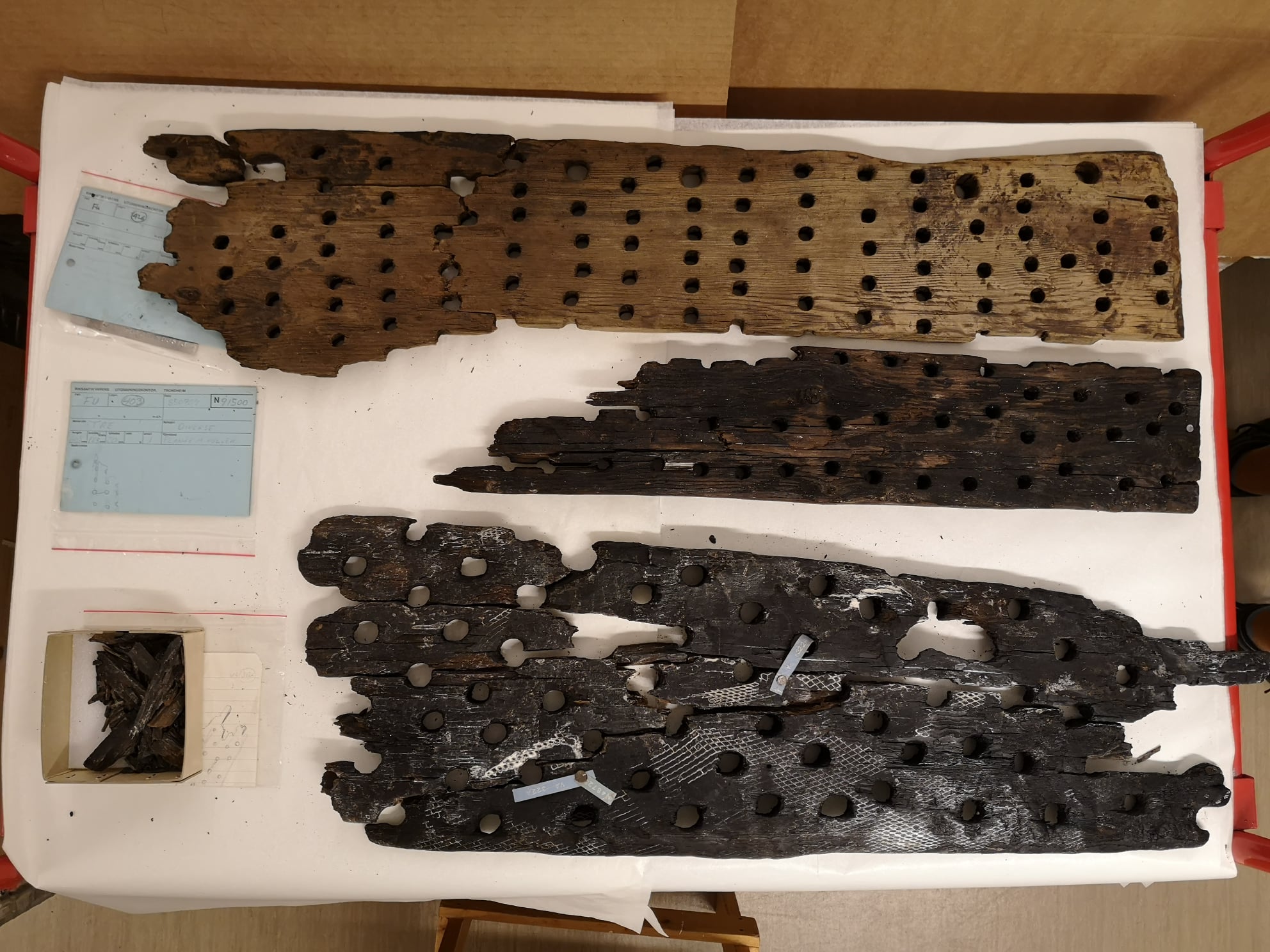
Three pierced planks dug out of the ground in Trondheim. Photo: Heidi Eltoft, NTNU Vitenskapsmuseet (with permission). |
In March 2021 Norwegian archaeologists posted the photo above on Facebook, asking their followers what they thought these planks might have been used for. The planks had been found during an archaeological excavation in the centre of the Norwegian city of Trondheim in the 1980s, but nobody had ever figured out what they had been used for. The planks were thought to date to the 12th century.
People suggested various uses for them, such as a grain sieve, a game board for playing a game with pegs, a lice board, and so on. One very vocal group insisted that the planks looked exactly like the boards that form the drying surface on top of a såinn, the traditional malt kiln still being used by farmhouse brewers in Stjørdal today. Stjørdal is roughly a 30-minute drive from Trondheim.
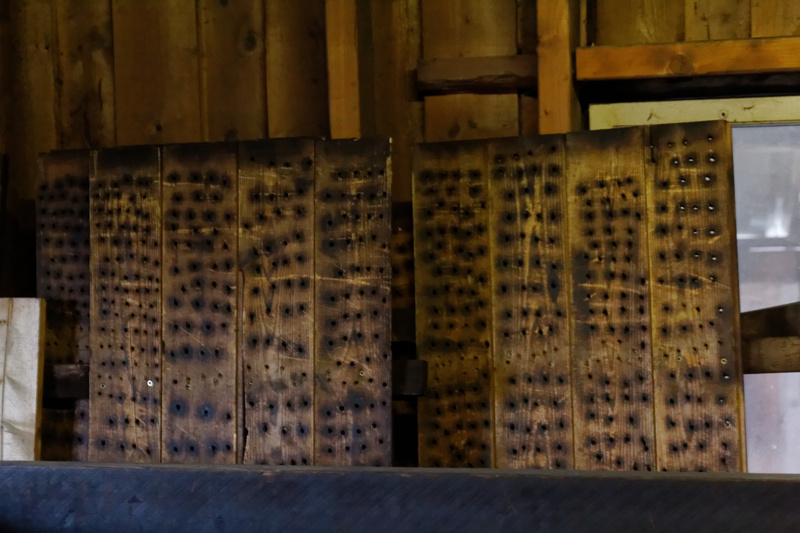
Såinn planks at Søndergården Såinnhuslag in Stjørdal. |
Unfortunately, several of the explanations fit the way these planks look, so any one of them, or even several, could be correct.
Closer examination of the planks did not yield anything definitive. One had been in close contact with honey or beeswax, to the degree that it reeked of it a millennium later. The holes were about 12mm in diameter. One had a burned edge, another was burned on one side, and the third on both sides. The burning might be consistent with use on a såinn, but it wasn't definitive.[3]
To try to get closer to an answer the group turned to the excavation report[1], to see exactly what sort of context the planks came from. The photo below shows building K57 in archaeological phase 5 (1150-1175 CE), since one of the archaeologists said he thought he remembered the planks being found in it. You can see there is a fireplace in the middle of the building, but what's interesting is over to the lower left side. A big flat stone, and then another stone structure just above it.
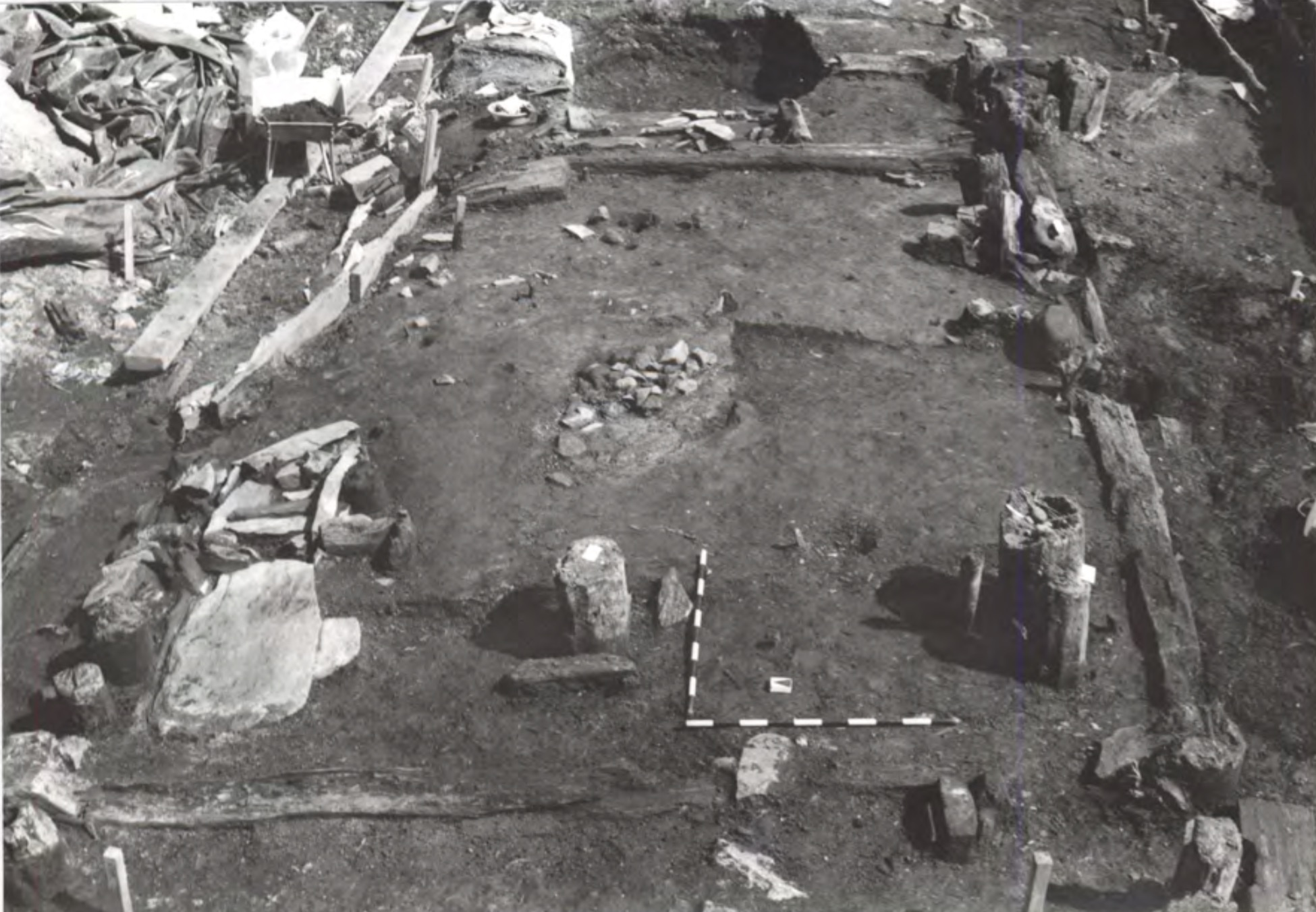
Structure K57 while it was being excavated. Photo: Riksarkivaren, with permission. (From [1].) |
In the report the archaeologists write that the strange structure above the flat stone was four stones, 5-10cm thick, standing on edge, which built "a sort of passage". There was a lot of ash there, and the archaeologists thought people had been burning firewood in this "passage". There were also wooden poles indicating that there had been some sort of wall around the "passage". Overall it was interpreted as a sort of baking oven.
But to anyone who's ever seen the inside of a såinn it immediately evoked something very specific. The fireplace inside a såinn is called "kjerringa" (the woman), and it's exactly like this "passage", except the big flat stone lies on top. The "wall" was likely the såinn itself. See the photo below.
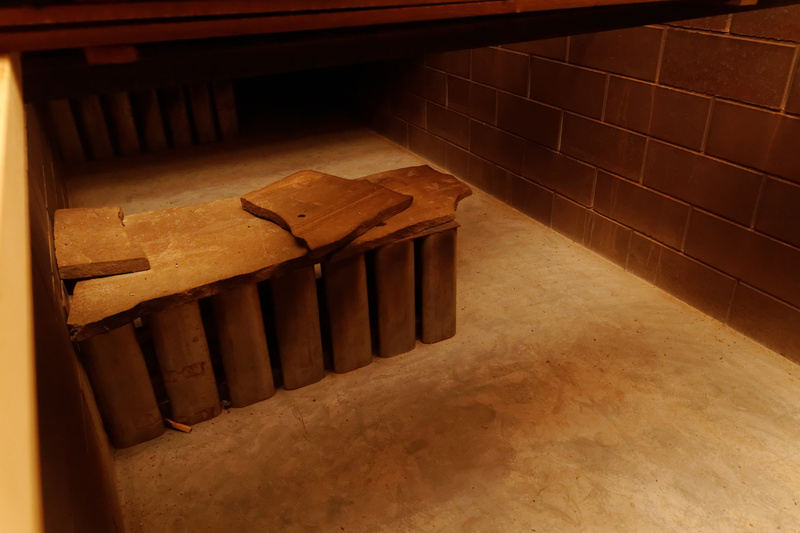
Looking inside a såinn with the planks taken off. The structure with the slate stone "roof" is kjerringa. Klostergården brewery at Tautra. |
Now that seemed promising! The planks might be from a såinn for to drying malts. If so, that would be exciting, as it would indicate that the såinn as a malt kiln has been in use more or less unchanged for at least a millennium.
Then I remembered something.
I had earlier read a report about a find of a suspected brewery in Trondheim, so I went back to that report[2]. Below is a drawing of the area where the suspected brewery was found.

Building 254 (upper left) and the area around it in phase 6. Photo: Riksarkivaren, with permission. (From [2].) |
The find turned out to be from the same excavation, and from the same sector of it, FU, in building 254, which was initially suspected of being a bakery. The interesting sample was number 88793 (see drawing), which consisted of straw, Myrica gale, and juniper. It was found just outside building 254. Myrica gale is a well-known brewing ingredient, which made the archaeologists wonder: "could the big room have been used for brewing beer"?
(Of course, alert readers are aware that juniper is even more significant, since it's being used in Stjørdal today.)
I started looking around to see how far away the såinn in K57 was, but then I realized: K57 and 254 were the same building! (Rotate the drawing above 90 degrees counter-clockwise to align with the photo of K57.) They had suspected the såinn of being a baking oven, and that's why they were talking about a bakery. So in the archaeologists had found Myrica gale and juniper right outside the suspected såinn. Just a couple of meters away from it, in fact.
(K57 was from phase 5, and 254 from "main phase 6", but it turns out the timing of these two overlap. Phase 5 in [1] is 1150-1175 CE, main phase 6 in [2] is 1125-1275 CE. Why the two are different in the two publications I'm not sure of.)
To me there seemed to be little reason to doubt that these herbs had been used in brewing. The straw was probably the filter in the lauter tun, possibly together with the juniper. The Myrica gale was very likely there for the flavour. In fact, it seems the typical way to use herbs in older farmhouse brewing was to put them in the lauter tun. They may have used hops as well, since they were found several places nearby, although they were thought to be for trade.
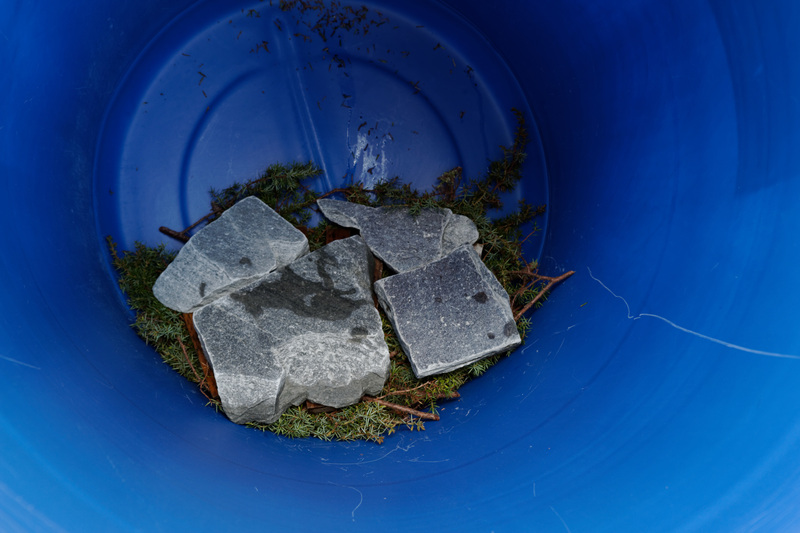
Juniper ready as the filter for lautering. Morgedal, Telemark. |
The whole thing seemed almost too neat.
Based on this I was able to get the archaeologist which originally posted the planks, Heidi Eltoft, to look at this more closely. Remember that the only connection between the planks and what we think may be a såinn is that one archaeologist thought he remembered them being found in the same building. It's forty years ago, however, so he might be wrong.
Heidi Eltoft kindly went back to Trondheim and looked through the archives, but was not able to pinpoint exactly where the planks were found. She got the numbers of the earth layers they were found in, but the information in the excavation report is not enough to say exactly where they are from. According to her a lot more work would be necessary to find the answers to that. Which is quite frustrating.
Let's review quickly what we know about the planks:
- One of them comes from an excavation at a different address nearby, so it's not related at to the suspected såinn or herbs at all.
- One is from earth layer 426. The report [1, p118] has a diagram showing the context, but it's very unclear. It's definitely from phase 3, which is before the phase the såinn is from. It could be in or close to building K35, but Heidi Eltoft says that's not certain. Building K35 is right underneath the såinn.
- The last one is from earth layer 403, from phase 4:2. The report [1, p125] is not clear on where that's from, but it appears to be not far from the såinn.
- In [1, p122] the report says two planks "with lots of drilled holes" were found in building K46 in phase 4:1. That's near the såinn. These are probably not our planks (wrong phase), but from the description they do sound like they look much the same.
The biggest problem with this is that all of these are from phases dated from before what we think is a såinn. The suspected såinn is from phase 5, while the planks are from phases 3 and 4:2. Plus we have (probably) two additional planks from phase 4:1.
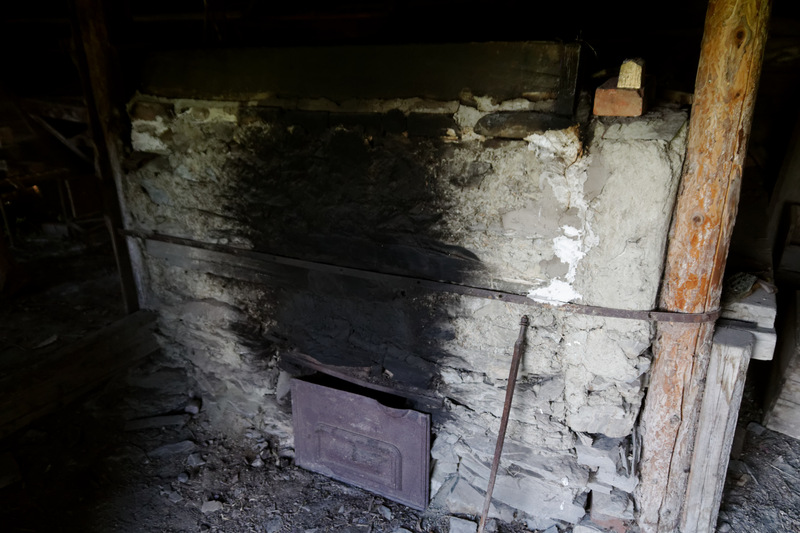
19th century såinn at Hegge farm, Stjørdal. |
If we review the evidence dispassionately, this is what we have:
- Straw, juniper, and Myrica gale was found, leading archaeologists to suspect building K57 was a brewery.
- Inside K57 is something that looks very much like a såinn, which strengthens that hypothesis.
- Nearby, from earlier date, two planks with lots of drilled holes were found, exactly like you'd expect såinn planks to look. It's possible that two more såinn-looking planks were found nearby, also from dates before K57.
If there was a såinn here in earlier phases, and traces of it disappeared because it was rebuilt, that would explain the planks being from earlier dates, but it's a bit of a weak link. The strongest evidence here is actually the association of brewing herbs with what looks like a såinn without planks.
So while this is not entirely conclusive, there is reason to suspect that someone made an 11th century stjørdalsøl here, with Myrica gale. That's not quite a beer recipe, but it's pretty close. People in Stjørdal have been talking about stjørdalsøl as a style of beer dating back to the viking age, and while that seemed plausible there was never any evidence for it.
Well, we've definitely moved closer to having evidence now. And the story isn't over yet: if some archaeologist could be persuaded to put in the time to figure out where earth layers 403 and 426 came from we might be able to get closer.
This little discovery is also interesting in another way: it shows how important it is for archaeologists to have some knowledge of ethnography. Basic technology changed very little over the millennia, which means that knowing ethnography is extremely useful for identifying objects and practices from the remote past.
Had the archaeologists who did this excavation in the 1980s known what a såinn looks like this story could have been very different.
Acknowledgements
Warm thanks to Roar Sandodden and Jørund Geving, for many discussions about this, and for making me aware of the Facebook posting and the connection with building K57.
Huge thanks to Heidi Eltoft who put in a lot of effort to find more information, and also was very helpful in reviewing my attempts at interpretation. I want to emphasize that she does not conclude that what was found was a såinn. She says "this is interesting", then adds that "I wish I could say this look promising, but I quite simply don't dare to with the information I now have." So this blog post is my interpretation, and not hers.
Sources
[1] Fortiden i Trondheim bygrunn : Folkebibliotekstomten. Meddelelse 4, Ulf Alström and Brian J. Hodkinson, NTNU Vitenskapsmuseet, 1986.
[2] Frukter, frø og andre makrofossiler: funksjoner og aktiviteter belyst gjennom analyser av jordprøver, Kerstin Griffin and Paula Utigard Sandvik, Fortiden Trondheim Bygrunn Folkebibliotekstomten Medd, 19:1-108, 1989.
[3] Lus eller øl i middelalderen? Heidi Eltoft, Spor nr 2, 2021, p28-31.
Similar posts
Stjørdalsøl — the tasting
During our 2014 farmhouse ale expedition, Martin and I visited Stjørdal, a region in Norway famous for the many farmhouse brewers who still make their own malts in the traditional way
Read | 2017-03-09 14:58
Dånnåbakken såinnhuslag
They call themselves Dånnåbakken Såinnhuslag, the group of 4-5 brewers and malters who share one brewery and malt kiln
Read | 2017-05-07 14:55
Svein, maltster and brewer
At first glance it looked like any house in the area, a two-storey wooden house
Read | 2017-03-19 11:17
Comments
bark - 2022-10-01 13:54:30
It would have been interesting to have the planks dendrochronologically dated to obtain greater precision in the dating.
Lars Marius Garshol - 2022-10-01 14:04:27
@bark: Absolutely. Or C14-dated. There's a lot more work that could be done here to bring greater clarity. But that requires getting the archaeologists properly interested. That's actually part of the reason to post this: I'm hoping to stir up interest. (I also did an article in an archaeological magazine that may be more effective.)
Dave Pawson - 2022-10-01 17:57:45
Lacking fine cloth (?), wood with 12mm holes, topped with moss / other natural material, would make a pretty effective sieve? Equally, it would allow heat to rise to whatever was above it. One to puzzle over Lars!
Lars Marius Garshol - 2022-10-01 18:24:55
@Dave: A sieve is definitely possible. It was one of the original suggestions (follow the link at the start of the article).
That still leaves the strange-oven-looking-exactly-like-a-såinn to be explained, though.
Jørund Geving - 2022-10-02 14:05:28
From the 15th century we have descriptions of soinn from Iceland. Here, sprigs of branches are used, instead of the planks. This is probably due to a lack of timber. By the way, the soinnplanken are called soinnspiler by some people here in Stjørdal even today. On top of these slats, the Icelanders put straw and at the top a horse blanket as a bed for the malt.
Roar Sandodden - 2022-10-04 15:01:56
I am not so confused that some of the sodnaspølir (Såinnplankene) seemingly were found a bit away from what appears to be the kiln. Maybe some of the old/burnt/damaged såinnplankene were just stoved away, soon to become firewood. Just like my old ones are at the moment :-) Or just put in a corner awaiting a new batch to be kilned.
Lars Marius Garshol - 2022-10-04 15:02:58
@Roar: The biggest issue is not that they were moved, but that they date from earlier periods. So effectively up to a century earlier.
Roar Sandodden - 2022-10-05 08:05:22
Continous kilning on that site for at least a century in other words :-)
Lars Marius Garshol - 2022-10-05 08:12:20
@Roar: I have to say that looks like the likeliest explanation to me.
Pedro Almada - 2022-10-07 16:20:57
Very interesting. Older people tended to just chuck things away so perhaps these planks got damaged enough to not be useful, got chucked in the mud and survived a rebuild of the kiln? Is that the idea?
Kiki - 2022-10-07 20:16:50
Muy buen articulo. Por lo leído y por las fechas me parece mas una elaboracion de un Braggot. Ya que por esos siglos los vikingos ya lo elaboraban, fusionando el Aguamiel con Granos y hierbas.Principamente por los ingredientes miel probablemente extrujada de panales de abejas, mas la combinación de granos malteados y la adición de hierbas tipo gruit para amargor. Interesante planteo ya que se habla en varios artículos sobre Braggot entre siglo lX al XI. Incluso anterior a esos siglos como a fechado Patrick MacGovern.
Lars Marius Garshol - 2022-10-09 21:25:46
@Pedro: Yes, that's pretty much it. As you use the planks the heat tends to wear quite heavily on them, and eventually they have to be replaced. I don't know if these were that burned, however.